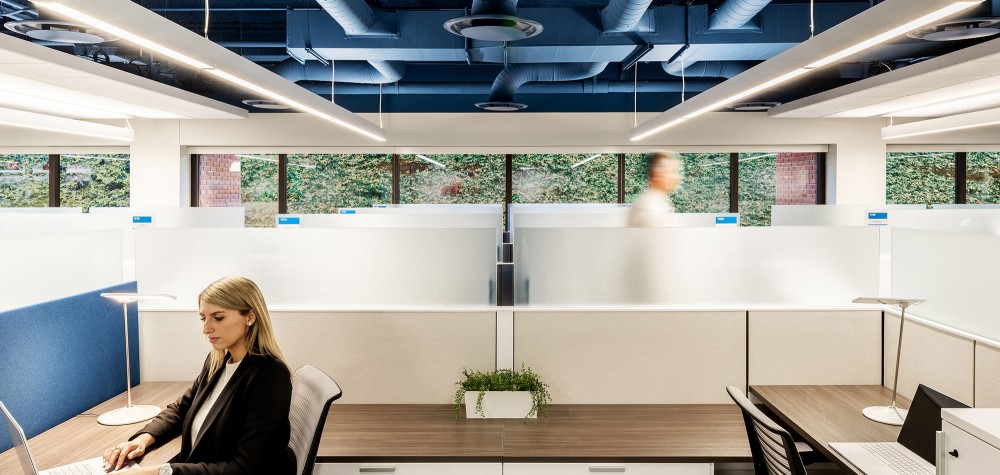Opinion: The Workplace is Alive and Well. Let’s Plan for It.
May 25th, 2020
In spite of many reports to the contrary, the shared workplace isn’t dead. In fact, it’s something we’ll need more than ever as this global calamity eases.
We heard Twitter’s announcement that their employees “could work remotely forever.” The truth is, we don’t all feel the same way about working at home — some love it, some don’t. A seminal study from five years ago showed that employee job satisfaction increases with each additional hour spent working remotely — but only until 15 hours. After that, it flattens.
For many of us, even when we can complete much of our work remotely and away from our colleagues and coworkers, we miss and need the collective culture of an office. There’s significant value in the sense of place and community that we associate with our headquarters, our shared offices, our physical workspaces. Some of us crave the connection to the buzz and the place that’s not home.
That said, returning staff have to feel completely confident of their return to the workplace. They reasonably expect that their office environments will be reevaluated — not just in terms of physical safety, but also to support their needs to feel belonging, inspiration, social contact and career support such as training and mentoring.
That’s why the transition back to the old office, which experts recommend as a phased process, will be easier for those organizations that have already wrapped a strong sense of wellbeing and positive culture into their workplace — and then made real efforts to sustain that culture during this period of remote work.
To the issues of confidence and safety, most companies will find it fairly easy to adapt to the CDC guidelines for housekeeping, social distance protocols, and operational aspects such as elevator access and touch surfaces. Employees won’t all return to the office at once, so there will be a long transitional period, easing us into the changes falling within the CDC framework.
Moreover, in the shared workplace itself, we’ll see opportunities to reorganize and retrofit the desks, meeting areas and shared zones to support not only safety but also the sense of appreciation and belonging that our workplaces confer. For employers, begin to design your revamped workplaces by considering pathways and spacing to meet distancing needs, barriers and partitions that help compartmentalize work spaces, and technologies that facilitate CDC compliance — headsets for phones and virtual meetings, for example, where participants remain at individual desks to eliminate conference room gatherings. Rarer but just as important, some situations will call for air filtering, humidity control and increased ventilation. Remember, though, that access to windows and daylight are vital to enjoyment and productivity, and that IT isn’t always the answer.
As for any hoteling and shared desk setups previously devised? Just eliminate those (for now). A clean-desk policy should be embraced instead so thorough, frequent scrubdowns can take place.
Then visualize and walk through how your offices and workplaces will be used, checking those scenarios against the procedures and operations you’ve committed to follow. Organizations will find that some will have options for downsizing, reducing space needs overall, while others will actually need more room to accommodate minimum distances between desks or workstations, for example. Some companies will adapt their so-called high-density workspaces for new uses. As we’re seeing among many organizations, a thoughtful redesign might be needed to retain aspects of their workplace culture and promises to employees.
The best and most valuable solutions will reinforce company identity and culture. Any short-term fixes must be thoughtful and in keeping with the organization’s already-established level of quality in the office. This thoughtful approach shows employees they are valued and important.
Think about ways to create delight and a sense of shared humanity: Perhaps new art, brand elements, and plantings? As people return to their workplaces, it’s important to maintain trust and build greater belief in why we work together, side by side. (Well, more than 6 feet apart, but together.) From the beginning of the process, plan ahead proactively to begin achieving buy-in for people in the first phases of workplace return. Strong communications are vital to managing misinformation and increasing trust.
Most of all, use remote working strategically, not as a panacea. A safe work environment is still essential for community, mentorship and personal and team growth. It helps in recruiting and retaining great talent, too. The work environment is a proven foundation of organizational growth and success.
Remote work is great for some people during certain times in their lives. But most employees will appreciate new opportunities for blending work and home, bringing a new level of job satisfaction.
In my own workplace, full of architects and designers, we’re creating short-term strategies that maximize employee safety for their return. But we’re also champions of long-term opportunities to make engaging and productive workplaces.
Our workplaces will come back and we look forward to it.
Also seen in
Stamford Advocate
Danbury News Times
New Haven Register









